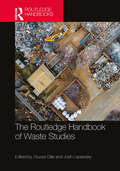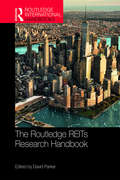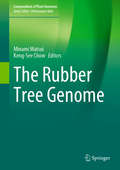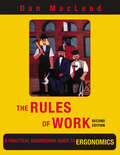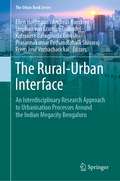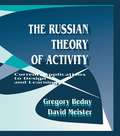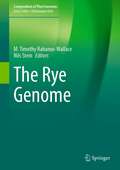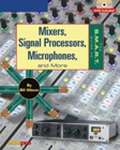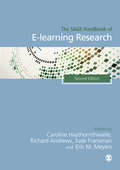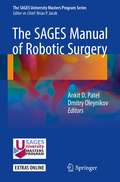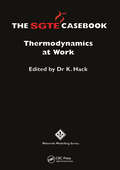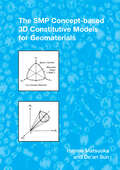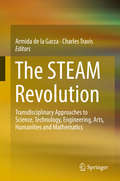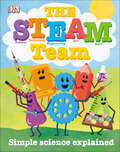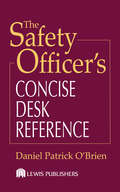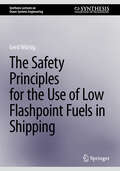- Table View
- List View
The Routledge Handbook of Waste Studies (Routledge Environment and Sustainability Handbooks)
by Zsuzsa GilleThe Routledge Handbook of Waste Studies offers a comprehensive survey of the new field of waste studies, critically interrogating the cultural, social, economic and political systems within which waste is created, managed and circulated. While scholars have not settled on a definitive categorization of what waste studies is, more and more researchers claim that there is distinct cluster of inquiries, concepts, theories and key themes that constitute this field. In this handbook the editors and contributors explore the research questions, methods and case studies preoccupying academics working in this field, in an attempt to develop a set of criteria by which to define and understand waste studies as an interdisciplinary field of study. This handbook will be invaluable to those wishing to broaden their understanding of waste studies and to students and practitioners of geography, sociology, anthropology, history, environment and sustainability studies.
The Routledge International Handbook of Engineering Ethics Education (Routledge International Handbooks of Education)
by Shannon Chance and Tom BørsenResponding to the need for a timely and authoritative volume dedicated to this burgeoning and expansive area of research, this handbook will provide readers with a map of themes, topics, and arguments in the field of engineering ethics education (EEE).Featuring critical discussion, research collaboration, and a team of international contributors of globally recognized standing, this volume comprises six key sections which elaborate on the foundations of EEE, teaching methods, accreditation and assessment, and interdisciplinary contributions. Over 100 researchers of EEE from around the globe consider the field from the perspectives of teaching, research, philosophy, and administration. The chapters cover fast-moving topics central to our current understanding of the world such as the general data protection regulation (GDPR), artificial intelligence (AI), biotechnology, and ChatGPT; and they offer new insights into best practices research to equip program leaders and instructors delivering ethics content to students.This Open Access volume will be of interest to researchers, scholars, postgraduate students, and faculty involved with engineering education, engineering ethics, and philosophy of education. Curriculum designers, staff developers teaching pedagogical courses to faculty, and engineering professionals may also benefit from this volume.The Open Access version of this book, available at http://www.taylorfrancis.com, has been made available under a Creative Commons Attribution-Non Commercial-No Derivatives (CC-BY-NC-ND) 4.0 license.
The Routledge REITs Research Handbook
by David ParkerThe Routledge REITs Research Handbook presents a cutting-edge examination of the research into this key global investment vehicle. Edited by internationally respected academic and REIT expert Professor David Parker, the book will set the research agenda for years to come. The handbook is divided into two parts, the first of which provides the global context and a thematic review covering: asset allocation, performance, trading, sustainability, Islamic REITs, emerging sectors and behavioural finance. Part II presents a regional review of the issues with high level case studies from a diverse range of countries including the US, UK, Brazil, India, Australia, China, Singapore, Israel and Russia, to name just a few. This handbook redefines existing areas within the context of international REITs research, highlights emerging areas and future trends and provides postgraduates, professionals and researchers with ideas and encouragement for future research. It is essential reading for all those interested in real estate, international investment, global finance and asset management.
The Rubber Tree Genome (Compendium of Plant Genomes)
by Minami Matsui Keng-See ChowThis book presents the first comprehensive compilation of genome research on the Hevea brasiliensis rubber tree. The genomes of Hevea tree clones (cultivars) are described by three major international groups. Chapters on omics-driven investigations address a broad range of topics including genome annotation and utilisation, transcriptome and gene family analysis, genetic mapping, metabolic pathways in latex and molecular breeding. Additionally, an overview of fundamental rubber biology, especially on laticifers, provides a historical background that is relevant to rubber genome analysis. The book concludes with several perspectives on the future needs of rubber investigations and prospects of rubber genomics. Given the scope of topics, this book will appeal to researchers and university students working in genomics and biotechnology of the rubber tree, and to rubber breeders with an interest in non-conventional approaches to trait analysis, selection and breeding.
The Ruin of J. Robert Oppenheimer and the Birth of the Modern Arms Race
by Priscilla McmillanIn a groundbreaking book that recasts the history of the Cold War, bestselling author Priscilla J. McMillan exposes, for the first time, the truth behind J. Robert Oppenheimer's 1954 trial on charges of violating national security. Drawing on newly declassified papers and extensive interviews, McMillan places Oppenheimer's opposition to development of the hydrogen bomb at the heart of the story--opposition that made him the victim of government officials who, conspiring with rival scientist Edward Teller, deceived President Eisenhower and trapped the enigmatic genius who had done more than anyone to build the atomic bomb. A chilling exposé of the McCarthy-era conspiracy that helped propel the East-West arms race, this is a spellbinding work of history.
The Ruin of J. Robert Oppenheimer: And the Birth of the Modern Arms Race (Johns Hopkins Nuclear History and Contemporary Affairs)
by Priscilla J. McMillanThis groundbreaking Cold War history reveals the government conspiracy to bring down America’s most famous scientist.On April 12, 1954, the nation was astonished to learn that J. Robert Oppenheimer was facing charges of violating national security. Could the man who led the effort to build the atom bomb really be a traitor? In this riveting book, Priscilla J. McMillan draws on newly declassified U.S. government documents and materials from Russia, as well as in-depth interviews, to expose the conspiracy that destroyed the director of the Manhattan Project.This meticulous narrative recreates the fraught years from 1949 to 1955 when Oppenheimer and a group of liberal scientists tried to head off the cabal of air force officials, anti-Communist politicians, and rival scientists, who were trying to seize control of U.S. policy and build ever more deadly nuclear weapons. Retelling the story of Oppenheimer’s trial, which took place in utmost secrecy, she describes how the government made up its own rules and violated many protections of the rule of law. McMilliam also argues that the effort to discredit Oppenheimer, occurring at the height of the McCarthy era and sanctioned by a misinformed President Eisenhower, was a watershed in the Cold War, poisoning American politics for decades and creating dangers that haunt us today.
The Rules of Work: A Practical Engineering Guide to Ergonomics, Second Edition
by Dan MacLeodThe experience of the past decade since the publication of the first edition of The Rules of Work: A Practical Engineering Guide to Ergonomics proves just how central ergonomics is for effective production. Revised and updated to reflect new insights from workplace developments, the second edition continues the tradition of providing essential tool
The Rumor Game
by Thomas MullenA determined reporter and a reluctant FBI agent face off against fascist elements in this gripping historical thriller set in World War II-era Boston from the multi-award-nominated author.Reporter Anne Lemire writes the Rumor Clinic, a newspaper column that disproves the many harmful rumors floating around town, some of them spread by Axis spies and others just gossip mixed with fear and ignorance. Tired of chasing silly rumors, she wants to write about something bigger. Special Agent Devon Mulvey, one of the few Catholics at the FBI, spends his weekdays preventing industrial sabotage and his Sundays spying on clerics with suspect loyalties - and he spends his evenings wooing the many lonely women whose husbands are off at war. When Anne's story about Nazi propaganda intersects with Devon's investigation into the death of a factory worker, the two are led down a dangerous trail of espionage, organized crime, and domestic fascism - one that implicates their own tangled pasts and threatens to engulf the city in violence. With vibrant historical atmosphere and a riveting mystery that illuminates still-timely issues about disinformation and power, Thomas Mullen delivers another powerful thriller.
The Rural-Urban Interface: An Interdisciplinary Research Approach to Urbanisation Processes Around the Indian Megacity Bengaluru (The Urban Book Series)
by Stephan von Cramon-Taubadel Ellen Hoffmann Andreas Buerkert Kotrakere Basegowda Umesh Prasannakumar Pethandlahalli Shivaraj Prem José VazhacharickalBengaluru is one of the fastest growing megacities in India. As such, it provides an in-situ laboratory for studying rural-urban transitions. While urbanization is most evident in the changing landscape with increasing built-up areas, it comes along with changes in ecosystem functions, new economic opportunities, changes in social organization and individual attitudes and behavior. All of these processes are interlinked and mutually depend on each other. This book attempts to integrate studies from a wide scope of disciplinary perspectives and at different spatial scales under the framework of complex social-ecological systems.Agriculture is the prime example of a system in which humans interact with their biophysical environment, and the production systems in the rural-urban interface are profoundly affected by urbanisation. Intensification and diversification of agriculture are immediate responses to urban pressures and demands, and are linked as much to resource (over-)use as to commercialisation. Yet, little is known about the spatial patterns of agricultural transformation in areas of urban sprawl.The focus of the contributions here is explicitly on the interface, in-between the rural and urban systems. It thus differs from the urban-centered perspective of city planners as well as from the rural predominance in most of the agricultural research. In the present volume this focus is implemented by analysing samples along a spatial gradient representing different stages of urbanization. Ongoing time series analyses and a panel study will complement the spatial approach by a temporal dimension.
The Russian Theory of Activity: Current Applications To Design and Learning (Applied Psychology Series)
by David Meister Gregory BednyThe opening of the former Soviet Union to the West has provided an opportunity to describe Russian human factors/ergonomics and to compare American theories and methods with it. Although this book is principally dedicated to describing the theory of activity as it applies to issues of design and training, it is also offered to a general audience of psychologists and interested lay readers. This theory studies the goal-directed behavior of man and attempts to integrate the cognitive, motivational, and behavioral aspects of activity into a holistic system. Such fundamental notions as goal, action, and self-regulation are described and analyzed from totally different theoretical points of view. This is the first comprehensive, systematic description of the theory of activity in the English language. Existing attempts to translate the theory of activity into English suffer from certain limitations. Among them, the theory of activity -- considered one of the more important accomplishments of Soviet psychological science -- has an extensive history dating back to the work of Vygotsky and his students. Subsequent development of the theory by other well-known Soviet psychologists and psychophysiologists took place within different schools with some significant differences. In the former Soviet Union, psychological theory could not be advanced unconnected to Marxist-Leninist ideology. Accordingly, theoretical formulations were subject to their own version of "political correctness." Books published in this field were addressed only to other scientists with backgrounds in the field. Moreover, the translation of the technical terms in Russian psychology frequently resist translation in the absence of the context of the debates in which they were being used. Thus, simple translation of books in this field as they were written in a specialized and politicized environment for Russian audiences is really not a particularly sensible or worthwhile undertaking. This book is addressed in the first instance to Western psychologists. It compares, among other things, analyses of work from the former Soviet Union with the work from the West. Applications of activity theory to design and learning were paramount in the Soviet Union. Using their own theoretical perspective, the authors provide a comparative analysis of the various schools working in activity theory. They hope that this book may facilitate the exchange of ideas between Russian psychological scientists and Western psychologists working in ergonomics, human factors, industrial/organizational psychology, education, learning, and related areas where the theory of activity may find general application. This book's authors attempt to provide a contribution not only to science but also to history. Western researchers have strongly influenced Russian work, but because of negative political pressure in the former USSR, the flow of concepts was one-sided. Russian ergonomists received so much from American and Western sources that it is now important to give something back. Despite the considerable similarity between Russian and American theories and methods, the special "spin" the former put on their work may stimulate new thinking on the part of their American colleagues.
The Rye Genome (Compendium of Plant Genomes)
by Nils Stein M. Timothy Rabanus-WallaceThis book celebrates the dawn of the rye genomics era with concise, comprehensive, and accessible reviews on the current state of rye genomic research, written by experts in the field for students, researchers and growers. To most, rye is the key ingredient in a flavoursome bread or their favourite American whisky. To a farmer, rye is the remarkable grain that tolerates the harshest winters and the most unforgiving soils, befitting its legacy as the life-giving seed that fed the ancient civilisations of northern Eurasia. Since the mid-1900s, scientists have employed genetic approaches to better understand and utilize rye, but only since the technological advances of the mid-2010s has the possibility of addressing questions using rye genome assemblies become a reality. Alongside the secret of its unique survival abilities, rye genomics has accelerated research on a host of intriguing topics such as the complex history of rye’s domestication by humans, the nature of genes that switch fertility on and off, the function and origin of accessory chromosomes, and the evolution of selfish DNA.
The S. M. A. R. T. Guide to Mixers, Signal Processors, Microphones, and More
by Bill A. GibsonAdvances in audio industry technology have opened up tremendous, new creative options. Musicians can now bend, shape, mold, stretch, tune, distort, and restore with an ease only imagined 10 or 15 years ago. Today, if you can imagine it, you can create it. The S. M. A. R. T. Guide to Mixers, Signal Processors, Microphones, and More covers the essential ingredients in audio recording -- core equipment, the building blocks of the entire technical and creative aspects of audio recording -- and includes an impressive DVD with more than 100 video and audio demonstrations that enhance and clarify the concepts in the book. You will cover specific techniques designed to improve the overall quality of your audio recordings, enabling them to viably compete with the music on your favorite professional recordings. Study recording examples that fit real musical situations, and learn solutions to common problems that will help you enhance your music. Put each new principle and concept into practice, combine it with your own creativity and imagination, and start cranking out the hits!
The SAGE Handbook of E-learning Research
by Eric M. Meyers Jude Fransman Professor Caroline Haythornthwaite Mr Richard N. L. AndrewsThe new edition of The SAGE Handbook of E-Learning Research retains the original effort of the first edition by focusing on research while capturing the leading edge of e-learning development and practice. Chapters focus on areas of development in e-learning technology, theory, practice, pedagogy and method of analysis. Covering the full extent of e-learning can be a challenge as developments and new features appear daily. The editors of this book meet this challenge by including contributions from leading researchers in areas that have gained a sufficient critical mass to provide reliable results and practices. The 25 chapters are organised into six key areas: 1. THEORY 2. LITERACY & LEARNING 3. METHODS & PERSPECTIVES 4. PEDAGOGY & PRACTICE 5. BEYOND THE CLASSROOM 6. FUTURES
The SAGE Handbook of E-learning Research, 2e
by Eric M. Meyers Richard Andrews Jude Fransman Professor Caroline HaythornthwaiteThe new edition of The SAGE Handbook of E-Learning Research retains the original effort of the first edition by focusing on research while capturing the leading edge of e-learning development and practice. Chapters focus on areas of development in e-learning technology, theory, practice, pedagogy and method of analysis. Covering the full extent of e-learning can be a challenge as developments and new features appear daily. The editors of this book meet this challenge by including contributions from leading researchers in areas that have gained a sufficient critical mass to provide reliable results and practices. The 25 chapters are organised into six key areas: 1. THEORY 2. LITERACY & LEARNING 3. METHODS & PERSPECTIVES 4. PEDAGOGY & PRACTICE 5. BEYOND THE CLASSROOM 6. FUTURES
The SAGES Manual of Robotic Surgery
by Ankit D. Patel Dmitry OleynikovThe SAGES Manual of Robotic Surgery is designed to present a comprehensive approach to various applications of surgical techniques and procedures currently performed with the robotic surgical platform. The Manual also aligns with the new SAGES UNIVERSITY MASTERS Program. The Manual supplements the Robotic Surgery Pathway from Competency to Proficiency to Mastery. Whether it's for Biliary, Hernia, Colon, Foregut or Bariatric, the key technical steps for the anchoring robotic procedures are highlighted in detail as well as what the reader needs to know to successfully submit a video clip to the SAGES Facebook Channels for technical feedback. Readers will also learn about how to count credits for Robotic from the other Master Program Series, Guidelines, Top 21 Videos, Pearls, FLS, FES, FUSE, SMART and Annual SAGES Meeting. The Masters Program promotes lifelong deliberate learning. The initial chapters are dedicated to the anchoring procedures needed to successfully navigate through the Masters Program. Subsequent chapters then address preliminary issues faced by surgeons and staff, such as training and credentialing, as well as instrumentation and platforms commonly used for these procedures. Individual chapters will then focus on specific disease processes and the robotic applications for those procedures. Written by unbiased experts in that field, each of these chapters address issues such as patient selection, pre-operative considerations, positioning and technical aspects of the most common operations, and avoiding complications. A brief review of the existing literature addressing the topics are also included in each section.
The SGTE Casebook: Thermodynamics at Work
by K. HackThe Scientific Group Thermodata Europe (SGTE) is a consortium involved in the development and application of thermodynamic databanks for materials such as metals. Building on SGTE research, the second edition of this standard reference presents thermodynamic calculations as the basic tools in developing and optimizing various materials and processes. The SGTE Casebook: Thermodynamics at Work, Second Edition shows how this data can optimize the production and quality of steel and other alloys. The book explores phases stable at equilibrium as well as their amounts and compositions, and provides information about the degree of instability of the phases not present at equilibrium
The SMP Concept-Based 3D Constitutive Models for Geomaterials
by Hajime MatsuokaThe Cam-Clay model is a fundamental constitutive model in soil mechanics, but is only suitable for normally consolidated clay under triaxial compression stress states. This book introduces the SMP criterion, its integration with the well-known Cam-clay model, and its application to the general eleastoplastic constitutive models for geomaterials like clay, sand and unsaturated soil.
The STEAM Revolution: Transdisciplinary Approaches to Science, Technology, Engineering, Arts, Humanities and Mathematics
by Charles Travis Armida de la GarzaThis volume is dedicated to collaborative research across STEM disciplines, the arts and humanities. It includes six sections, framed from a global perspective and exhibits contributions from key experts in the field, emerging scholarly voices, and STEAM practitioners. The added value of STEAM projects in research is highlighted in the first section of this book. Ranging from the spatial, medical and environmental humanities to heritage science, this section discusses the course and paths STEAM projects may evolve to in the near future. The second section features reflective essays by scientists and artists on the development of their research, their professional growth and personal learning experiences that the art/science collaborations have afforded their work and careers. Sections III and IV provides practical guidance and advice on facilitating STEAM teams and describe successful collaborative projects. By presenting the objectives and outcomes of relevant research, the chapters in these sections discuss the various steps taken by different teams to achieve project fruition. Paying particular attention to barriers inhibiting STEAM collaboration, these sections also explore the ways in which research teams were able to work effectively. The fifth section presents a review of policy issues and the potential impacts of STEAM research for administrators, funders and policy makers. In its pursuit for balance and inclusion, the volume concludes with a critical reflection on STEAM that argues a different perspective and will prove food for thought to readers.
The STEAM Team: Simple Science Explained
by Lisa BurkeThe zany characters of The STEAM Team will guide kids through this engaging, fact packed kid's book all about the key subjects - science, technology, engineering, art, and math.An excellent introduction for children ages 5-7 to understanding these concepts, The STEAM Team is a colorful, well-presented education book for children that will get your little ones crazy for STEAM subjects!This brightly illustrated science book for kids breaks down STEAM subjects and complicated ideas into fun and easily understandable pieces. Join The STEAM Team to unravel the mysteries of science for kids - find out how robots work, what a food chain is, where lightning comes from, and much more!The STEAM Team characters (Science, Technology, Engineering, Art, and Math) guide the reader through the book and are always on hand with tips, fun facts, and simple explanations. The ingeniousness of The STEAM Team is the characters - keeping little ones engaged and engrossed throughout. In these pages the Team cover living things, the human body, space, physics, geography, math, engineering, and chemistry. This book is a fantastic first children's book for kids starting to learn STEAM subjects in school, or who are developing an insatiable interest in the world around them.Meet The Steam Team!The STEAM Team is made up of five cool characters (subjects) that work together to show you how the world works. Science is all about asking questions and discovering the answers to explain how things work. Technology uses science to create new machines and effective ways of doing things. Engineering is all about finding and designing solutions to problems - using science, technology, and math. Art is all about using your imagination and style to create brilliant new things. Math is about numbers, patterns, and problem solving. They are the perfect team to teach you all about STEAM - Science, Technology, Engineering, Art, and Math!Find out what science is, why it is so important, and how it relates to the world around you. Discover how machines work, what a food web is, why boats float, where lightning comes from, and much much more!From Amphibians to Darwin to the Internet, this book is full of interesting STEAM facts covering: - The Universe- Plants- Robots- The human body- Measuring- Climate Change- And so much more!If you are looking to add more books to your collection that answer the questions about the world, give Ask A Scientist a try for the little "why?" askers in your life.
The STEM Night Disaster (Kate the Chemist)
by Kate BiberdorfThe third installment of the Kate the Chemist series that shows kids that everyone can be a scientist!Kate's school is having their first-ever STEM Night and the prizes are incredible! Kate is determined to win and comes up with the perfect experiment. But as she and her best friend, Birdie, start preparing, they find that Kate's project keeps getting messed up. Will Kate be able to use her science know-how to find out who is behind the STEM night sabotage? And will she fix her project before it's too late?Praise for Kate the Chemist: Dragons vs. Unicorns:"Proves that science and fun go together like molecules in a polymer."--School Library Journal"It's a great introduction to the basics of Chemistry that is readily accessible to a variety of ages . . . . The way the everyday chemistry is blended in is done seamlessly, and has [me and my ten-year-old son] noticing how we are all doing a little bit of science everyday." --GeekMom.com
The STEM Shift: A Guide for School Leaders
by Ann P. Myers Jill BerkowiczAll you need to make the shift to STEM a reality! Now more than ever, educational leaders are encouraged to implement STEM as the foundation for preparing students with the 21st century skills required for college and career readiness. This resource makes the process of shifting to a comprehensive, integrated STEM school or district within reach! Invaluable case studies featuring current STEM pioneers from across the country model how successful, STEM-centered learning takes place. You’ll find process-specific best practices and strategies to help you: Understand, create, and lead the STEM change process Transform existing school programs Prepare the school community for STEM and plan for STEM integration Integrate 21st Century Skills, the arts, and humanities Create essential partnerships with business and higher education Includes step-by-step checklists and visual mapping guides for successfully navigating the STEM change process. Use this groundbreaking resource to systematically implement coherent and integrated STEM instruction that transforms learning and prepares students for the global economy! Video and web content also available at http://bit.ly/TheSTEMShift. "Finally! A great book that clearly explains what STEM education is, why we need it, and how to do it well. A must-read for all educators, parents, and policymakers." Tony Wagner, author of The Global Achievement Gap and Creating Innovators "Reading Jill and Ann′s column in Education Week has been a critical part of my weekly reading since they′ve begun writing it. I′ve learned a lot from those short snippets, and now it′s exciting to see their expanded thoughts in The Stem Shift. You can′t go wrong by reading anything they write!" Larry Ferlazzo, High school teacher and Ed Week columnist
The STEM Shift: A Guide for School Leaders
by Ann P. Myers Jill BerkowiczAll you need to make the shift to STEM a reality! Now more than ever, educational leaders are encouraged to implement STEM as the foundation for preparing students with the 21st century skills required for college and career readiness. This resource makes the process of shifting to a comprehensive, integrated STEM school or district within reach! Invaluable case studies featuring current STEM pioneers from across the country model how successful, STEM-centered learning takes place. You’ll find process-specific best practices and strategies to help you: Understand, create, and lead the STEM change process Transform existing school programs Prepare the school community for STEM and plan for STEM integration Integrate 21st Century Skills, the arts, and humanities Create essential partnerships with business and higher education Includes step-by-step checklists and visual mapping guides for successfully navigating the STEM change process. Use this groundbreaking resource to systematically implement coherent and integrated STEM instruction that transforms learning and prepares students for the global economy! Video and web content also available at http://bit.ly/TheSTEMShift. "Finally! A great book that clearly explains what STEM education is, why we need it, and how to do it well. A must-read for all educators, parents, and policymakers." Tony Wagner, author of The Global Achievement Gap and Creating Innovators "Reading Jill and Ann′s column in Education Week has been a critical part of my weekly reading since they′ve begun writing it. I′ve learned a lot from those short snippets, and now it′s exciting to see their expanded thoughts in The Stem Shift. You can′t go wrong by reading anything they write!" Larry Ferlazzo, High school teacher and Ed Week columnist
The Safety Anarchist: Relying on human expertise and innovation, reducing bureaucracy and compliance
by Sidney DekkerWork has never been as safe as it seems today. Safety has also never been as bureaucratized as it is today. Over the past two decades, the number of safety rules and statutes has exploded, and organizations themselves are creating ever more internal compliance requirements. At the same time, progress on safety has slowed to a crawl. Many incident- and injury rates have flatlined. Worse, excellent safety performance on low-consequence events tends to increase the risk of fatalities and disasters. Bureaucracy and compliance now seem less about managing the safety of the workers we are responsible for, and more about managing the liability of the people they work for. We make workers do a lot that does nothing to improve their success locally. Paradoxically, such tightening of safety bureaucracy robs us of exactly the source of human insight, creativity and resilience that can tell us how success is actually created, and where the next accident may well happen. It is time for Safety Anarchists: people who trust people more than process, who rely on horizontally coordinating experiences and innovations, who push back against petty rules and coercive compliance, and who help recover the dignity and expertise of human work.
The Safety Officer's Concise Desk Reference
by Daniel Patrick O'BrienAs a safety manager in today's work environment, you wear hats in many different fields. Sometimes you need only a specific formula or drawing to understand the current situation. This resource supplies it. Or maybe you want to know where to find more information on a specific subject. This resource has it. The Safety Officer's Concise Desk Reference gives them the essentials to get through the task immediately before them by providing the information they need to understand the issues and solve their problems effectively. It covers the basics in a user-friendly format with specific references of where and how to obtain additional information on a broad range of subjects, including industrial hygiene, ergonomics, risk management, fire safety, and workers' compensation. With an extensive list of references and a glossary of terms this book supplies a quick and accurate source of essential safety information.
The Safety Principles for the Use of Low Flashpoint Fuels in Shipping (Synthesis Lectures on Ocean Systems Engineering)
by Gerd WürsigTechnical rules like the IGF code are developed by large groups of experts over long periods of time. Explaining the background for the requirements of such rules is not part of the development process. As a result, the reasoning behind the rules is often lost over time, or at least hidden from the end user of the rules. The purpose of this publication is to explain the safety principles behind the rules for unconventional marine fuels. It is the author's hope that an understanding of the safety principles will contribute to the technology-based interpretation of the rules and their further development.
